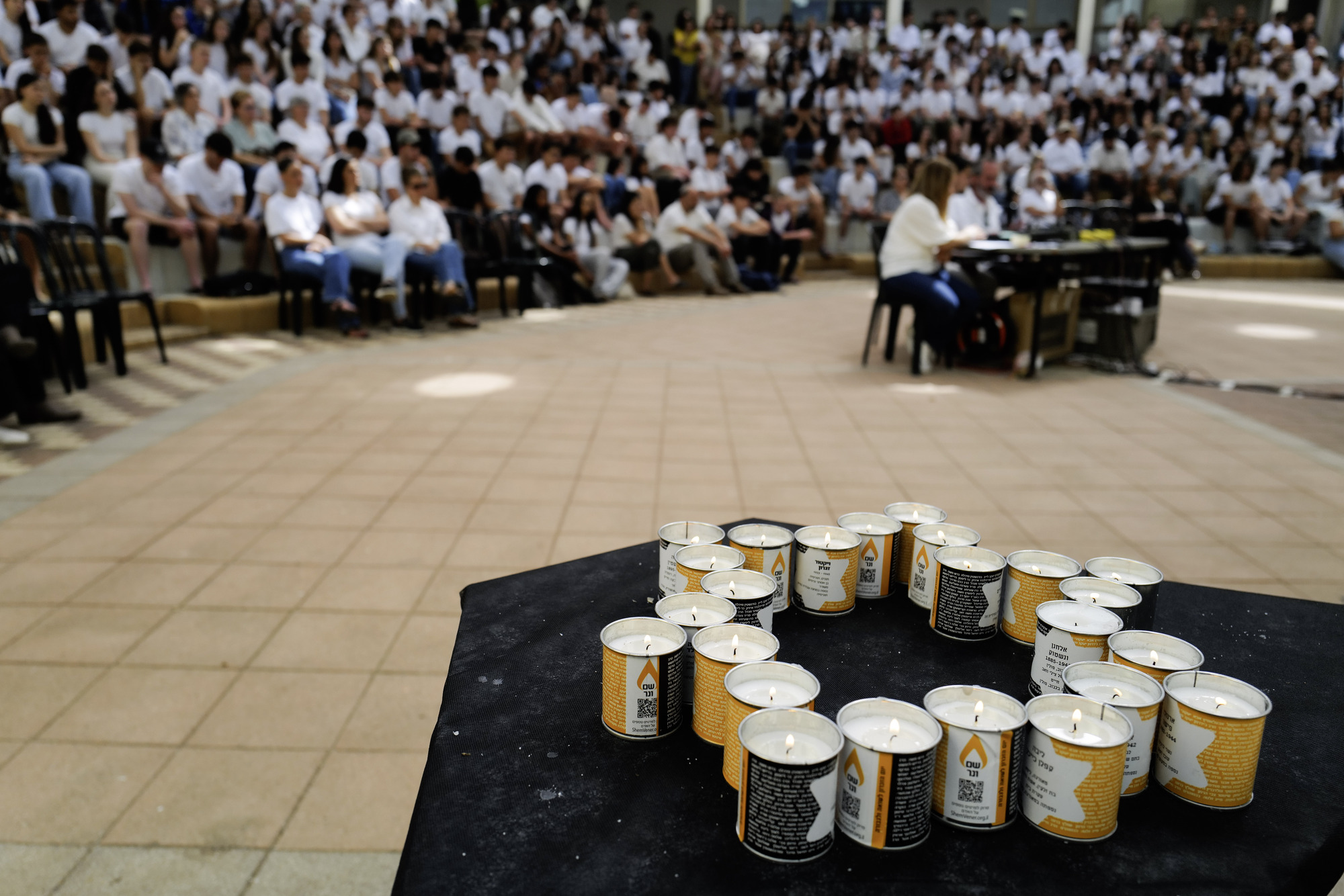Yellow Stars and Yellow Ribbons: Lessons and Limits of Linking Holocaust Memory to October 7
Linking October 7 to the Holocaust shapes Israeli memory and identity—but while the parallels evoke deep emotion, this connection must also serve as a call for democratic resilience, not a retreat into victimhood.

Photo by Michael Giladi/Flash90
The memory of the Holocaust in Israeli society has shifted and evolved within the collective consciousness over the years, shaped by various milestones in Israel’s history. For example, Israeli high school students journey to Poland, which has become a formative experience in the Israeli socialization processes, and later, the IDF incorporated these journeys into its officer training programs as part of shaping the ethical and moral character of senior commanders. The military journeys have also influenced the broader contours of Holocaust remembrance in Israeli society. One powerful example is the image of the Israeli Air Force flyover in September 2003 above the Birkenau camp during a “Witnesses in Uniform” delegation ceremony — a now-iconic photograph displayed in the offices of senior commanders and government ministers. These developments have further sharpened the army’s role in shaping collective memory — as the protective force that embodies the promise of “Never Again.”
On the surface, the events of October 7 seem to reinforce the increasingly strong connection over the years between Jewish existence in the State of Israel and Jewish existence during the Holocaust, despite significant differences in historical circumstances, global context, and the capabilities available to the State of Israel in confronting ongoing threats to its security. The need for a sovereign Jewish state and for an army were among the most fundamental lessons Zionism drew from the Holocaust. But for at least 30 hours on October 7, 2023, that lesson was not applied—for the first time since the establishment of the state. In those hours, the state and the military failed to protect thousands of its citizens. This was a formative moment in that devastating day and carries profound implications for Israeli identity and the national ethos.
The horror of the October 7 massacre instantly connected, in the collective consciousness, to the events and terrors of the Holocaust. This is the second year in which these commemorative days are held in the shadow of the war that began in its aftermath—a war whose end is not yet in sight. Israeli society, more polarized than ever, is locked in a bitter political and social struggle. It is the second year in which the remainder of our hostages have yet to be returned by the state nor the military. The emaciated bodies and psychological trauma of the survivors who have returned flashed in our mind to images of Holocaust survivors. Across the country, various memorial and remembrance events are drawing explicit connections between the two. For instance, Holocaust survivors who lived in the Gaza envelope and survived the October massacre now face a dual trauma. Similarly, Poland delegations and “Zikaron BaSalon” (living room memorial events that take place on Yom HaShoah across Israel) now feature both Holocaust survivors and October 7 survivors — from the Gaza border communities and from the Nova festival.
The yellow ribbon symbolizing the campaign to return the hostages is increasingly integrated into Holocaust Remembrance Day posters, evoking one of the central symbols of Jewish experience during the Holocaust, the yellow star.
We are therefore in the midst of another formative moment in the evolution of our collective Holocaust memory in Israeli society—even an intensification of this memory and its influence on Israeli identity and on how current events are understood and interpreted. In his 1980 essay “The Holocaust – A Crossroads,” A. B. Yehoshua wrote:
"Anyone who seeks to present the Holocaust as yet another expression of Jewish fatalism essentially asserts that this pattern of relations is beyond repair, that we have no control over our destiny, that we are moving in a circle with no exit."
As much as the emotional and immediate connection is understandable, especially given that the events of October 7 are unprecedented in Israeli and Jewish history since the Holocaust, it is also critical to recognize the differences between the two periods and events. Memory entrepreneurs—those who shape our collect memory—are not waiting for the “day after” the war. The processes of shaping collective memory are already underway - in school ceremonies, in the public space, and in the discourse across social media.
At this stage, this connection appears important, but we must not allow it to reinforce a sense of Israeli victimhood and the nationalistic sentiments that often accompany it. Alongside the importance of remembrance and commemoration, this represents a serious risk to the possibility of societal recovery in Israel.
The Holocaust was indeed an event of far-reaching consequence for the entire world, and especially for the Jewish people. More than anything, it taught what can happen when a state disintegrates from its institutions and its humanistic and democratic values, and what the cost is of moral numbness and passive complicity in the face of suffering.
The great tragedy that befell us on October 7 must not serve as proof that “we move in an endless, inescapable cycle.” Because if that is so, there can be no renewal.
In this moment, alongside the lessons learned from comparisons between the Holocaust and October 7, Holocaust Remembrance Day should also stress the elements from which we can draw strength for a better future: the importance of a stable democracy; the rejection of all forms of racism; and the human capacity — like that of the Holocaust survivors who immigrated to Israel and were integral to its establishment and development — to rise from the ashes and do good in our world.
